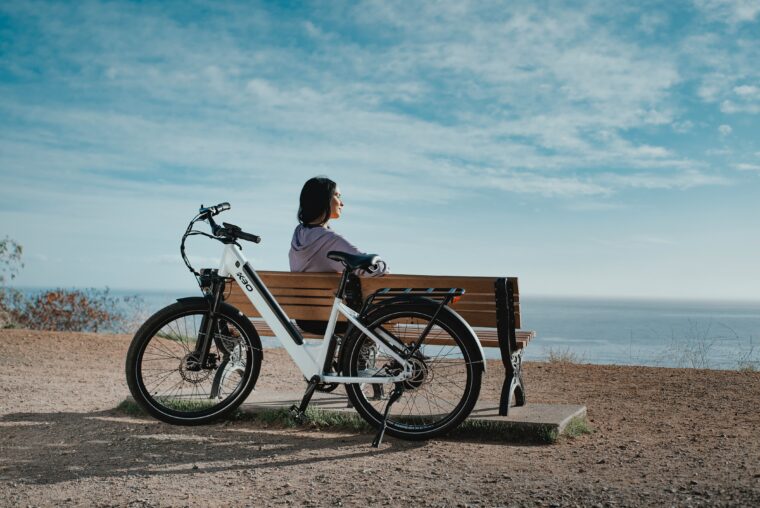eBike with Belt Drive; Are Belt Drive eBikes Worth it? How Do They Stack Up Against Other eBike Types?

If you are a diehard rider, you might have tried different types of bikes already. But have you laid your hands on e-bikes? I mean, the one with a belt drive? If not, then you’re probably missing out on some really good fun.
But hey, there is a whole spectrum of bike models and types out there to sample, so there’s every chance you just bumped into electric bikes.
These are some of the most fun, effective, and classy bikes that you can ride on different terrains. Yes, even on trails.
But why eBikes? What are the different types available besides the ones with a belt drive? And are they even worth your money and time?
That is what I am going to go over right here, right now. So stick around, and let’s take a deep dive into the nuts and bolts of these bikes.

First things first…
What are the 3 types of eBikes?
You might not have figured it out yet, but eBikes come in different types – three to be more specific; the belt drive ebike, the mid-drive e-bike, and the hub motor e-bike.
So, what makes each of these bikes stand out? Let’s take a quick overview of each bike.
The belt drive e-bike?
The belt drive e-bike is a pretty common type among the different e-bikes out there. It is often made using polymer materials with carbon fibers used as tensile strength.
The bike’s chain links to the rear wheel, which receives the energy you exert on the bike when pedaling – more specifically on the cog area.
The mid-drive e-bike?
The mid-drive type features a motor that sits smack bang between the pedals at the very center of the bike. The bike’s cranks attach directly to the motor, which in essence, is part of the bike’s frame.
Then there is a drivetrain that powers the bike – as you pedal, the motor will turn the cranks, and then a chainring delivers the power from the exerted force to the rear wheel.
One cool thing about this bike is that the motor provides some pedaling force on the cranks, also known as pedal assist, which makes pedaling the bike easier.
The hub motor e-bike
Unlike the mid-drive e-bike, the hub motor type features a separate unit that is not inbuilt into the frame.
This one has a motor that is built into a hub.
Also, it stands out from the two bikes we’ve looked at above. How? Well, you can install its motor either in the front or rear wheel.
The hub motor turns the wheel on which it is attached, essentially applying torque directly to that particular wheel. And yes, this is executed separately from the bike’s drivetrain in that gear changes don’t have any effect on the hub motor.
Hub motors often come in two types; geared and gearless ones. The gearless type is the more common of the two thanks to its simplicity mechanically since they don’t feature any moving parts apart from the bearings on the hubs.
Also known as direct drive, this is a common type in most entry-level e-bikes.
Now that you know the different ebike types on the market, it’s time to kick the tires on the belt-drive ebike.
Is a belt drive e-bike worth it?
Each of the different types of ebikes out there is great in its own right. But most bikers seem to veer towards the belt drive one.
What gives it the edge to reign supreme in such a competitive market?
I have to admit. I have taken an unrivaled liking to this particular model too. But since we’re all different, I will take you through what I find fascinating about each of them and let you decide who’s the clear winner.
To get rolling, let’s start with the belt drive one. Shall we?
So, what’s cool about the belt drive ebike?
This one has several cool perks that make it stand out, at least for me. Here are some of the ones I can’t help loving.
The durability is remarkable
The question of durability is hands down one that you can’t scratch off your head when thinking of investing in any machine, and these bikes are no exception.
Thing is, unlike chain drives, belt drives do put up quite a fight, even against such odds as exposure to rain or moisture. Even with premium materials, chain drives can rust or corrode in such adverse conditions.
Belt drives, on the other hand, are made of carbon fiber, which is very resilient, and rarely affected by harsh conditions like rain or heat. The belt drive also features a high-resistance material, which helps protect the belt if it gets in contact with the bike’s cog.
This also means the belt drive needs less maintenance, which is a pretty cool perk.
They weigh less
If you will be bringing your bike on outdoor fun adventures, and you’ll need to haul it occasionally, then it needs to be as light as they come. That’s another advantage you get with a belt drive.
But this advantage comes at a cost. The issue with belt drives is that they can be a little finicky with gears. So you have two options, use the bike as a single-speed bike, or compromise on the lightweight and install an internal gear hub – they tend to work great with these.
Not to worry though, unless you will be taking on hilly areas, you should be just fine with a single-speed bike.
The fit is snug and sure
While chain drives can derail from the bike’s components, a belt drive fits snugly with very little chance of the drive slipping off. This offers you the convenience and peace of mind you would ask for in a bike, and further ensures better safety overall.
Guarantees a quieter ride
One thing that puts me off on a bike (or any other workout machine for that matter) is when it starts making some funny sounds. This can be the case with some chain drives in instances where the chains clamp together – more so when the chains start wearing out.
Belt drives take this nuisance out of the question thanks to their quiet operation. If you’re like me and enjoy riding in the quiet back roads, then you will appreciate a dead silent belt drive.
Now that we have gone over the perks that you can get with a belt drive, let’s take a glance over what gives a chain e-bike the edge.
Chain drive benefits
There are several of these, but I won’t go into all the meat and potatoes of each…let me just list them here real quick;
- They are more affordable
- You can choose from a variety of motors
- The parts are rather easy to replace
- They work great with various frame types
Are Hub drive ebikes any good?
Having looked at the benefits of a belt drive e-bike, and a chain one, it’s only fair that we also glance over those of the hub drive e-bikes too so….
- Hub drive requires low maintenance
- They are quite affordable
- You can choose from several hub motor models
- A throttle control feature allows you to enjoy a ride without pedaling
- Some can convert the momentum into power and charge the unit’s battery
Which e-bike drive is best?
Honestly, there is no good or bad ebike. What works for you might not work for someone else. Picking the perfect bike for your needs boils down to your needs and preferences. And mostly, you should go for what piques your interest while also offering you the convenience you are looking for in an e-bike.
These three types of e-bikes are all cool, what matters is what you are looking for and how your bike of choice measures up.
Are electric bikes good for exercise?
It might seem counterintuitive that one would use an e-bike for exercise. After all, we’re used to other types of indoor and outdoor exercise bikes.
Turns out, you still can exercise on an e-bike.
Sure, you may not hit your max heart rate, but you can bet these boys will still make you break a sweat as can be seen on this ride by cycling coach Tom Bell, who is also an elite rider. The only difference an e-bike brings into the action is the additional assistance, as Bell puts it.
Researchers at the Birmingham Young University in Utah also set on a quest to figure out whether an e-bike would give riders any substantial exercise.
They measured the heart rate of seasoned mountain bikers on conventional bikes and then on e-bikes.
Turns out, the difference isn’t as significant as you might expect it to be. Riders using e-bikes still managed to hit up to 94% of the heart rate readings shown in traditional mountain bikes.
This goes to answer the next question I have been getting often lately…
What are the benefits of riding an electric bike?
As you can tell from the two examples above, e-bikes can offer almost all the benefits you would get with a normal pedal-powered one. You can still work your muscles, and improve your cardio.
The only difference is that an electric bike takes that top-end sting you would get with a conventional bike out of the ride. Hence, it will take you longer to hit your goals. Other than that, however, you can still make the most of your e-bike if it’s all you’ve got and still want to do aerobic or cardiovascular workouts.
Resources;
https://us.honbike.com/blogs/news/how-to-choose-between-belt-drive-and-chain-drive-ebike
https://wheretheroadforks.com/mid-drive-vs-hub-motor-e-bike-pros-and-cons/
https://www.bikeradar.com/advice/fitness-and-training/electric-bike-fitness/
